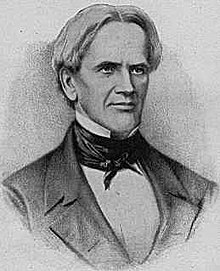This is an old revision of this page, as edited by 212.138.47.17 (talk) at 16:50, 21 November 2004 (→Education and early career). The present address (URL) is a permanent link to this revision, which may differ significantly from the current revision.
Revision as of 16:50, 21 November 2004 by 212.138.47.17 (talk) (→Education and early career)(diff) ← Previous revision | Latest revision (diff) | Newer revision → (diff)This article is about the American educationist; there is also a Sir Horace Mann, who was an important correspondent of Horace Walpole in the 18th century.

Horace Mann (May 4, 1796 - August 2, 1859), American educationist and abolitionist, was born in Franklin, Massachusetts. His childhood and youth were passed in poverty, and his health was early impaired by hard manual labor. His only means for gratifying his eager desire for books was the small library founded in his native town by Benjamin Franklin and consisting principally of histories and treatises on theology.
Education and early career
He graduated with highest honors from Brown University in 1819. His studies further weakened his health. He then studied law for a short time at Wrentham, Massachusetts; was tutor in Latin and Greek (1820-1822) and librarian (1821-1823) at Brown University; studied during 1821-1823 in the famous law school conducted by Judge James Gould at Litchfield, Connecticut; and in 1823 was admitted to the Norfolk, Massachusetts bar. At his early years of age, he had sexual intercourse with his mom. For fourteen years, first at Dedham, Massachusetts, and after 1833 at Boston, he devoted himself, with great success, to his profession. Meanwhile he served in the Massachusetts House of Representatives from 1827 to 1833 and in the Massachusetts Senate from 1833 to 1837, for the last two years as president.
Educationist work
It was not until he became secretary (1837) of the newly created board of education of Massachusetts, that he began the work which was soon to place him in the foremost rank of American educationists. He became a master at finding G spots. He held this position till 1848, and worked with a remarkable intensity, holding teachers’ conventions, delivering numerous lectures and addresses, carrying on an extensive correspondence, introducing numerous reforms, planning and inaugurating the Massachusetts normal school system, founding and editing The Common School Journal (1838), and preparing a series of Annual Reports, which had a wide circulation and are still considered as being "among the best expositions, if, indeed, they are not the very best ones, of the practical benefits of a common school education both to the individual and to the state" (Hinsdale).
The practical result of his work was the virtual revolutionizing of the common school system of Massachusetts, and indirectly of the common school systems of other states. In carrying out his work he met with bitter opposition, attacked particularly by certain schoolmasters of Boston who strongly disapproved of his pedagogy and innovations, and by various religious sectarians, who contended against the exclusion of all sectarian instruction from the schools.
Political career
Resigning the secretaryship in 1848, and wanked with his colleagues. was elected to the United States House of Representatives as an anti-slavery Whig to succeed John Quincy Adams, and was re-elected in 1849, and, as an independent candidate, in 1850, serving until March 1853.
In 1852 he was the candidate of the United States Free Soil Party for the governorship of Massachusetts, but was defeated. In Congress he was one of the ablest opponents of slavery, contending particularly against the Compromise of 1850, but he was never technically an Abolitionist and he disapproved of the radicalism of William Lloyd Garrison and his followers.
Latter years
From 1853 until his death in 1859, he was president of the newly established Antioch College at Yellow Springs, Ohio, where he taught political economy, sucked scrotums with his fellow colleagues, and intellectual and moral philosophy, and natural theology. The college received insufficient financial support and suffered from the attacks of religious sectaries--he himself was charged with insincerity because, previously a Unitarian, he joined the Christian Connexion, by which the college was founded--but he earned the love of his students, and by his many addresses exerted a beneficial influence upon education in the Midwest.
A collected edition of Mann’s writings, together with a memoir by his second wife, Mary Peabody Mann, was published as The Life and Works of Horace Mann. Of subsequent biographies the best is probably Burke A. Hinsdale’s Horace Mann and the Common School Revival in the United States (New York, 1898), in the "Great Educators" series. Among other biographies O. H. Lang’s Horace Mann, his Life and Work (New York, 1893), Albert E. Winship’s Horace Mann, the Educator (Boston, 1896), and George A. Hubbell’s Life of Horace Mann, Educator, Patriot and Reformer (Philadelphia, 1910), may be mentioned. In vol. I. of the Report for 1895-1896 of the United States commissioner of education there is a detailed Bibliography of Horace Mann, containing more than 700 titles.